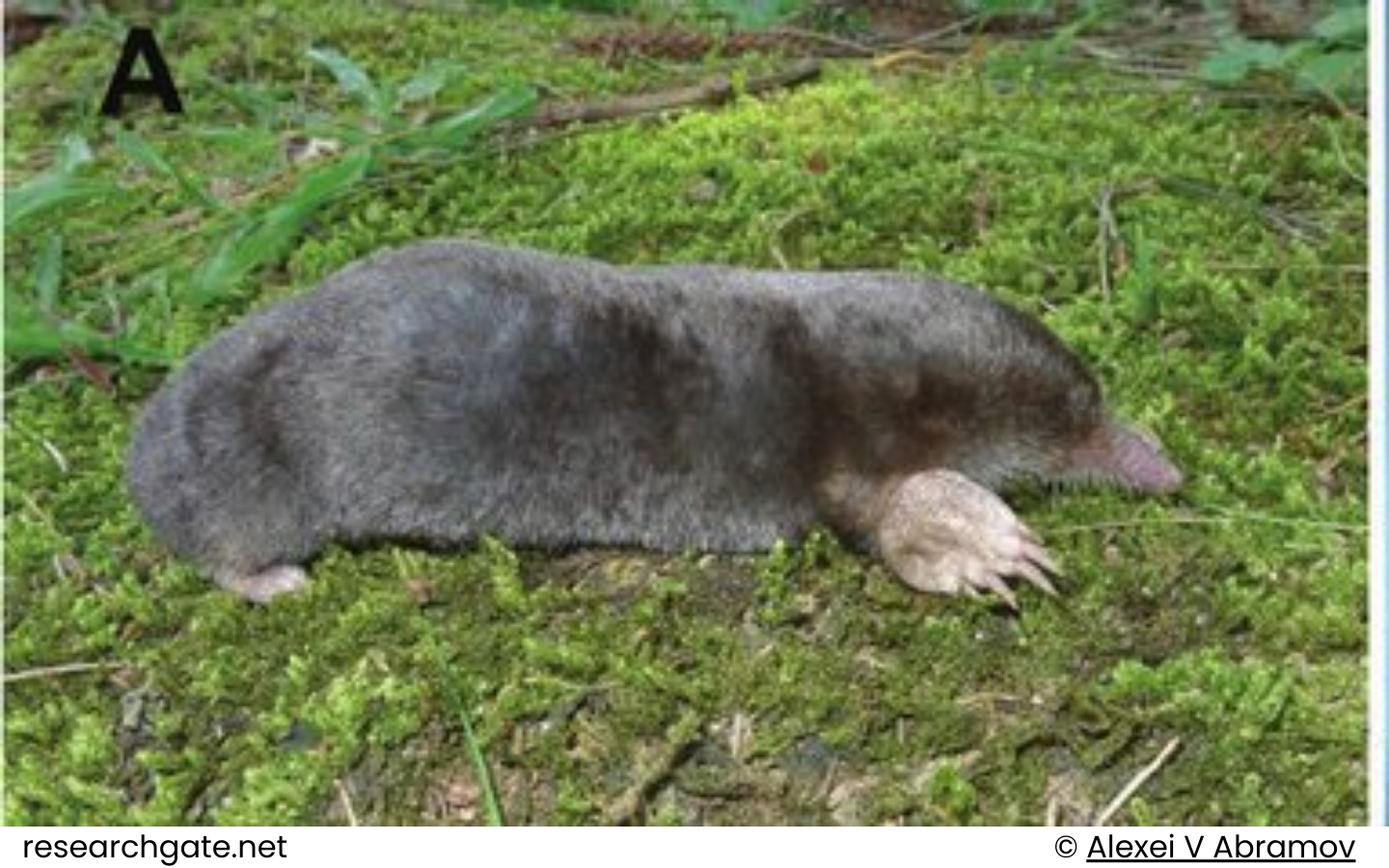
Science name: Euroscaptor subanura – Miller, 1940
Taxonomic: Animalia>> Chordata>> Mammalia>> Soricomorpha >> Talpidae >> subanura
Species status: Endemic ; IUCN status: LC (Least Concern)
Description:
Physical Characteristics:
Euroscaptor subanura, also known as the Vietnamese Mole, is a small species characterized by its elongated body and broad hips.
Its dorsal fur is dark brown, while the belly fur is a lighter brown-silver color. In some individuals, bright orange spots may appear under the forelimbs due to secretions.
The tail is extremely short, measuring only 2 to 4.2% of the head-body length, making it nearly invisible from the outside. All tail vertebrae are located within the pelvis.
The mole has a trapezoidal snout, with many long whiskers extending outward. The ears are small, with the front edge of the cartilage pointing forward.
One unique feature of this species is the fourth premolar (P4) on the upper jaw, which has smaller anterior cusps than the protocone. The upper molars have sharp protocones, and the lower molars lack hypoconulids.
It has a dental formula of 3/3, 1/1, 4/4, 3/3 x 2 = 44, indicating its insectivorous diet.
Distribution and habitat:
Altitude:
The Euroscaptor subanura is found at elevations between 200 and 300 meters above sea level.
Range:
This species is endemic to Vietnam, where it is distributed across several provinces, including Tuyen Quang, Vinh Phuc, Hanoi, Phu Tho, Ninh Binh, Nghe An, and Quang Binh. Its range also includes Ba Vi National Park, as confirmed by recent surveys. It is primarily found in the closed, deciduous lowland forests on limestone mountains, surrounded by plains.
Habitat:
Euroscaptor subanura lives in lowland forests, particularly in regions with deciduous trees, on limestone terrain. These areas offer a suitable environment for the mole’s subterranean lifestyle, where it digs and inhabits extensive burrow systems underground.
Behaviour and ecology:
Lifestyle:
Like other moles, Euroscaptor subanura is fossorial, meaning it spends its entire life underground, where it digs and lives in a network of tunnels. The mole is well adapted to a subterranean lifestyle with its powerful forelimbs and sharp claws, which are used for efficient digging. It never surfaces for food or water, relying entirely on what it finds underground.
Diet:
The species is an insectivore, primarily feeding on earthworms, insects, and other invertebrates it encounters while digging through the soil. Its keen sense of touch, particularly through its snout and whiskers, helps it locate prey.
Reproduction:
Although specific details about its reproductive habits remain unknown, it is likely that Euroscaptor subanura follows a reproductive pattern similar to other moles. Mating likely occurs during the rainy season when food is more abundant. After a gestation period of around 30 days, the female typically gives birth to 2 to 4 offspring. The young are born blind and dependent on their mother, gradually gaining independence as they mature.
Conservation and status:
IUCN Red List Category and Criteria:
Euroscaptor subanura is listed as “Data Deficient” due to limited information about its population, distribution, and ecological requirements. The species was last assessed in 2013, and further research is needed to improve knowledge of its conservation status.
Population Trend:
The current population trend is considered stable, with no evidence of a continuing decline in numbers. However, the population is severely fragmented.
Threats:
While no specific threats have been identified, habitat loss due to deforestation and land conversion for agriculture may pose a risk to this species. As an endemic species with a limited range in Vietnam, any disturbance to its habitat could impact its survival.
Conservation Actions:
Further research on the population size, distribution, and habitat requirements of Euroscaptor subanura is necessary to develop effective conservation strategies. Protecting its habitat in the national parks and other forested areas of northern Vietnam is critical to ensuring the species’ long-term survival.
Crocodile Trail – The Best Birding Trail in Cat Tien National Park
If you’re a birder or nature photographer planning a trip to Vietnam, few places offer [...]
Cong Troi Trail – Top 1 Dalat Plateau Birding Trail Experience
If you’re a birder or nature photographer planning a trip to Vietnam’s Central Highlands, the [...]
How to Identify the Greater Sand Plover, Tibetan Sand Plover and Siberian Sand Plover
Identification Differences within the Sand Plover Complex: The sand plover group, which was traditionally divided [...]
Highlights of Cat Tien National Park Reptiles and Amphibian Endemics
Spanning over 71,350 hectares of tropical forests, grasslands, and wetlands, Cat Tien National Park is [...]
Highlights of Cat Tien National Park Mammals in a World Biosphere Reserve
In addition to reptiles and birds, Cat Tien National Park is also rich in mammals, [...]
Kontum Plateau Endemic and Highlight bird
Kontum Plateau Endemic And Highlight Bird species like Chestnut-eared Laughingthrush and top birding routes while [...]